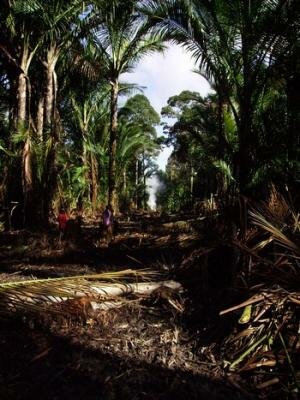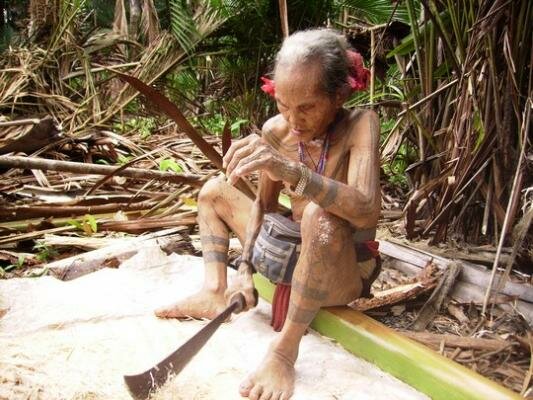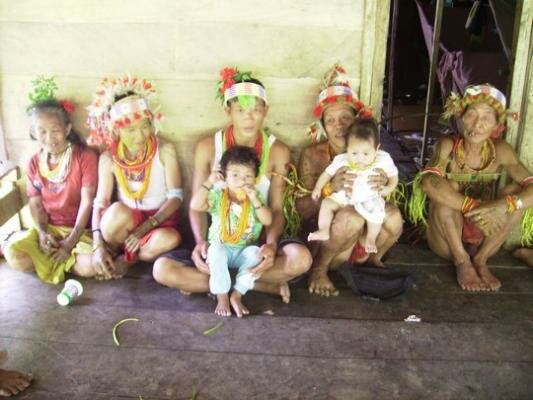White Rice or Black Sago?
On the island of Siberut, eating rice is both a status symbol and a sign of destruction of traditional ways.
 ‘It makes your hands dirty while eating’. When I lived recently for several months in the village of Muntei on the island of Siberut, I heard local people say this a lot about roasted sago. Roasted sago indeed blackens and chars when it cooks, but it is something the people here eat almost every day. Siberut is part of the Mentawai Archipelago, 100 kilometres off the coast of West Sumatra in the Indian Ocean. Sago is the main staple food for the people of the archipelago. Even so, Mentawaians increasingly prefer to eat rice, if they can.
‘It makes your hands dirty while eating’. When I lived recently for several months in the village of Muntei on the island of Siberut, I heard local people say this a lot about roasted sago. Roasted sago indeed blackens and chars when it cooks, but it is something the people here eat almost every day. Siberut is part of the Mentawai Archipelago, 100 kilometres off the coast of West Sumatra in the Indian Ocean. Sago is the main staple food for the people of the archipelago. Even so, Mentawaians increasingly prefer to eat rice, if they can.
Yet attempts to grow rice on the island have failed, despite government efforts to encourage its cultivation and to create a local population self-sufficient in food. A few irrigated rice fields close to the homes of migrants, who would probably have grown rice anyway, are the only tangible result of the government’s attempts to promote rice cultivation. Like most indigenous residents of Siberut, the people of Muntei don’t plant rice. They say it is not part of their tradition. It’s also difficult to grow in the swampy areas at the back of their village.
Why the taste for rice?
If they don’t grow rice, why do so many of the people of Mentawai not only like to eat it, but also think it is better than sago? The short answer is that rice has become a prestigious symbolic food, due both to its price tag and its imported nature. In Siberut, if you are able to consume rice a few days a week, you are classified as being well-off. Such a diet indicates that you are in business, or that you sell cash crops which enable you to buy food, instead of having to work outdoors to harvest your own.
Moreover, local people value rice not only because they see it as a luxurious food for the wealthy, but also because they value it as being ‘modern’ and ‘developed’. Mentawaians notice that sago is not usually eaten by the city people and others they watch on television in the evenings. Instead, it is considered a ‘primitive’ food, eaten mostly by remote Papuans, upstream Dayaks or by people in islands a long distance away, such as in Maluku.
This attitude is also reinforced by the government sponsored family food supplement program, Raskin, which is short for ‘beras miskin’ or ‘rice for the poor’. In Mentawai, as elsewhere, that program does not supply the local sago staple food, but rice to poor families. The social signal this program sends is that ‘everyone should have rice to eat’, reinforcing the message that sago and taro are second grade foods.
A status symbol
During a recent field trip to Mentawai, I had an interesting experience while living with a local family in Muntei. Every day for several months, we sat together and ate sago with condiments for lunch and dinner. In the mornings, we enjoyed a variety of cooked bananas, taro, tubers and cassava snacks. It was our habit to have lunch and dinner at the back of the family’s traditional Mentawai house, near the kitchen.

One day, the family’s oldest son, who was about 18 years old, came home for a visit after recently being employed in a workshop in Muara Siberut, a harbour town about ten kilometres from Muntei. He arrived with a full ten kilogram bag of rice. The youngest, six year old Edo was very happy and asked his mother to cook rice for lunch. After the food was ready to be served, I put some plates out on the just-swept floor in the kitchen, but instead Edo’s mother asked me to take the plates to the front of the house on the veranda.
This surprised me because normally we would eat lunch conveniently in the kitchen area. In answer to my question why we should move to the front, she responded that it was too hot to eat in the kitchen. Her reasoning was unconvincing, but she was firm, so the plates and pots were moved to the veranda. While helping me to carry the plates and glasses to the front, Edo explained: ‘If we were eating sago today, it wouldn’t matter if we had lunch in the kitchen. Kak [older sister], we are lucky, we eat rice today, so it’s better to have lunch on the veranda. There people can see what we are eating. In the kitchen they can’t.’
It became clear that the family didn’t want to hide the occasion of eating rice from others in the village. People are proud when they eat rice. Besides, serving rice to guests is now considered to be more courteous and a sign that you are honoured by their presence. It seems that it is no longer enough to honour guests with sago. Since hearing this explanation, I observed similar situations in other settings.
A staple food
Sago palms proliferate around Muntei village because of the abundance of wet and waterlogged soil there. When people cut down a sago tree there are always some saplings in the vicinity which will take its place. After about eight years, the new trees are ready to be harvested. Normally, one good mature sago tree can produce sufficient starch for a family of four or five for about eight to ten weeks. A whole trunk of processed starch will not spoil for many months if stored with care in tapirs (cylinder-shaped containers made from sago leaves) and left standing in a cool place in the house.
A harvested tree will normally produce about half a dozen good size tapirs. About 60 per cent of the trunk contains starch. The process of collecting the sago starch requires a large sieve, a big spiky rasp, a dugout canoe and plenty of fresh water which is always easy to find. When the sago tree has been felled, it is cut in sections and split in two. People then grate the pith or heart of the tree with the big rasp, releasing the starch and inedible fibres. They then put this mixture in the large sieve on a platform and with nimble feet and plenty of water wash the fibres and collect the starch in the dugout canoe underneath the sieve.
 The wet starch settles quickly on the bottom of the canoe and the water can be reused to wash the next batch of mixed starch and fibres. The fibres are spread around in the field and used to fertilise the next stand of trees. When the canoe is filled with wet starch, leaves of the just-felled sago tree are arranged to make a tarip. The sago starch which looks like wet flour but feels like clean coarse mud is packed inside the tarip. This is carried home and covered.
The wet starch settles quickly on the bottom of the canoe and the water can be reused to wash the next batch of mixed starch and fibres. The fibres are spread around in the field and used to fertilise the next stand of trees. When the canoe is filled with wet starch, leaves of the just-felled sago tree are arranged to make a tarip. The sago starch which looks like wet flour but feels like clean coarse mud is packed inside the tarip. This is carried home and covered.

















